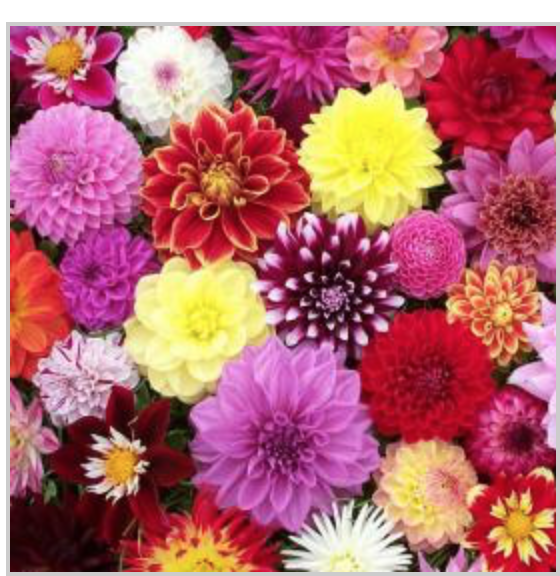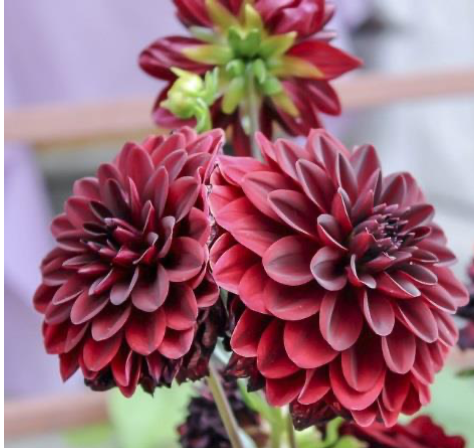DAHLIAS – Herbaceous Ornamental
WHY DAHLIAS NOW ?

They are a reliable flower with intense reds, yellows, even violets. They are easy to grow, but bloom mid- summer to fall, not spring. Then I was reminded by a friend that “April is still winter in Maine”. I pondered this and then concluded, there is not much else I can do in the garden right now. I have removed most of the fall leaves that formed my winter mulch. I have edged and pulled out creeping Charlie.
I have attempted and failed to budge the lily of the valley pips poking little white heads above the soil. I cannot dig them out between the large boulders. I will have to wait until they bloom and pick the flowers, preventing more seeding. The little white bells do have a lovely fragrance. Apparently, sun will limit growth and next year I may need a more drastic plan. Their rhizomes spread relentlessly, just under the soil. I will try horticultural vinegar on the field violets, leaving some to bloom, but taming the invasion.

MAINE VERSUS CONNECTICUT Climate wise
I started growing dahlias in coastal CT where summers are long and winters mild. They are currently at the end of tulip season, with leaves emerging on the trees. In Maine, I have my first daffodil on April 24. The last average frost day here is May 21-31, a long wait to plant tender perennials and annuals. Today is another rainy, windy Monday, better to read a book by the fire, than brave the outside. There is too much rain to fertilize, sprinkle grass seed, or apply organic weed preventer.
I am determined to save dahlia tubers from CT. They have bloomed for 2 seasons up to now. I find the idea of propagating, new plants from old comforting. I read what I could in books about overwintering dahlias and consulted web sites and videos. There was a lot of good information on storing dahlia tubers but not quite enough to cover my situation.

PLANTING
Dahlias in April in Maine are an inside sport. Planting can begin 3-4 weeks before they are transferred outdoors. Tubers can be purchased now, packed loosely in a little peat moss. The small clumps resemble fingerling potatoes tied together. Like potatoes, plant growth occurs from eyes peeking out from the necks or crowns of the tuber. First, a reddish stem can be seen, and then delicate, green leaves follow. Each eye may form a new plant. They should not be put in the ground until danger of frost has passed. Frost dates in any area can be found by asking Google and inserting your zip code.

I plant indoors in 8inch plastic pots with a mix of half potting mix and half peat, keeping it moist but not wet. I found references to several different planting mixtures including pure peat moss. OOOPS. In writing this article, I found a recommendation to place the plants on their side. Too late for me for this year. The potted tubers should be stored in a cool location (55-65’F) until it is time to plant in the ground. I found reference to both dark and light storage rooms, including greenhouses for early growth. In the ground they will need a mixture of soil, compost and peat. A dose of fertilizer and good drainage.
Optimal drainage is important but is not as I thought. I knew water needs to move quickly away from the crown of the plant. It passes through pores in soil, in the spaces between the soil particles. Coarse particles of soil like sand have large spaces and water passes through quickly. As particles get smaller the spaces are narrower and transit slower. Clay soil has fine particles with the least space. It can hold on to water too long, damaging plant roots.
RULE 3; GRAVEL AT THE BOTTOM OF A POT DOES NOT HELP DRAINAGE AS WATER DOES NOT MOVE WELL FROM SMALL PORES TO LARGE ONES. IF YOU MUST PUT SOMETHING DIFFERENT AT THE BOTTOM OF A POT USE MATERIAL WITH A SMALLER PORE SIZE, SUCH AS A DENSE CLAY RICH SOIL OR ORGANIC MATTER, OR NEWSPAPER.

FLOWERS
The dahlia flowers arrive on the long sunny lazy days of midsummer with copious blossoms that thrive for days to weeks. If you pinch off the first small buds especially on side shoots the blooms are supposed to be larger. Dahlias come in long- stemmed (36-40”) varieties that need to be staked early in their growth. Staking later could penetrate the tuber damaging it. I prefer the shorter heights, (24-28” or 12-14”), as they are easier to manage. Medium height and shorter varieties take kindly to containers as long as the containers are at least 12 inches deep with good drainage. They prefer rich soil, 2 parts compost to 1 part peat. Fertilize after sprouting with a low nitrogen liquid fertilizer (5-10-10 or 10-20-20). Repeat every 3-4 weeks until early Autumn. Too much nitrogen leads to more green and fewer blooms.

My first summer in Maine, I planted several tubers in the ground, and a few in large plastic rectangular containers with soil 12 inches deep. The container plants needed quite a bit more frequent watering. I used a mix of 1/3 peat, 1/3 soil, and 1/3 compost. (There are premixed soils sold for containers.) I lined the bottom with denser, but still porous landscape fabric to help modulate the speed of drainage. The containers were placed in front of the house in full sun in May when danger of frost was past. I fertilized with a flower friendly fertilizer, guaranteed to give the largest most abundant blooms, and I waited. Green stems and leaves grew readily.
What I did not appreciate at first, was the effect of a large white ash tree, (pictured in my first garden entry), in front of the house. It leafed out in early June, and as it did, began to block the sun. At first there was a beautiful dappled shade in the morning. As the canopy became denser light was increasingly blocked. My plants was healthy, but with more stems and leaves. There were very few flowers. I had to move several heavy, earth- filled, containers to a better location, resulting in many unnecessary days of back pain.
RULE 4; MOST MISTAKES CAN BE RECTIFIED.
I successfully moved my planters to a sunnier location. Dahlias need at least 6 hours of sunlight daily for beautiful flowers. New varieties, now available, include rag mop style flowers that look spectacular. A large multi-layered flower with a plethora of petals may be gorgeous, but it can shield the stamens, bearing pollen, and pistil, where the nectar lies. It may be difficult for pollinators to reach these inner parts. I prefer the more open, daisy like composite varieties. There is an abundance of choice and color for each height. Red flowers are most attractive to hummingbirds. Butterflies drink the nectar through their long proboscis. Deadheading dahlias throughout the summer leads to a longer blooming season.

AUTUMN CARE
When autumn arrives, flowering slows. By the first hard frost leaves blacken and wilt. Last fall, in Maine, I was faced with a choice, either leave them in the ground, discard them, or save them for the next year. I decided to save them for the next year, although overall it may be cheaper to buy new. I like the idea of continuity, conservation, and the plants multiply through division.
Fortunately, for me, the dahlias should be removed from the ground before the very heavy containers would have to be brought indoors. I left a couple of plants in flower beds and in containers in the barn, where I knew they would freeze, as an experiment. They were protected from wind and snow. Basically, I was too lazy to store all the bulbs I had accumulated. This spring I found the tubers left in soil, had actually disintegrated. There were some dead roots in the pots. One had a tuber that fell apart in my hands.

STORAGE
To store, I first cut off all the frost -bitten greenery. After gently lifting out the plants, the remaining stems were cut to 6 inches above the crown. You are supposed to hose down all earth completely before preserving, but I found it impossible to remove every grain of soil. Each dahlia plant is made up of a clump of fingerlings. Some people divide the tubers in the fall. I prefer to do it in the spring when I can find the eyes more easily. They should dry out for a couple of days, upside down. I then placed them in a box with peat moss. Perlite or coconut fiber, or plain brown bags work too. Several plants can be in the same container. Too many layers could lead to plant rot. I misted the dry tubers with very little water. I covered the peat with a bit of newspaper to assure darkness and retain moisture. I had several tubers totally dehydrate becoming unusable when I did not add a spritz of water every 2 months. I also had a tuber grow moldy with too much water. The balance is delicate.
Onion or lemon mesh bags were also recommended to hold the bulbs in a box with no other medium. This allowed easy inspection of the tuber, but I was afraid that would result in more shriveling. I almost forgot a most important rule.
RULE 5; LABEL EACH TUBER WITH ITS FULL NAME, COLOR AND HEIGHT
Thus, ends the year of the dahlia. I hope you have as much pleasure as I do watching them grow. Next up will be compost, then weeds.
An informative post. Thanks for sharing your pretty flowers.
LikeLike